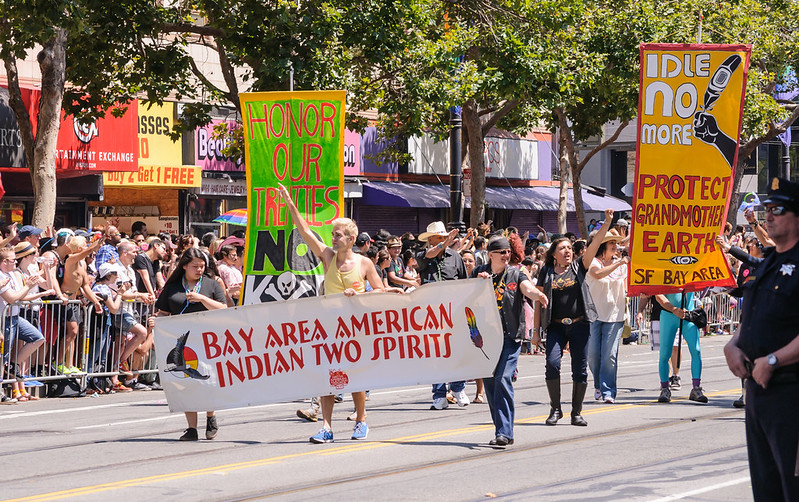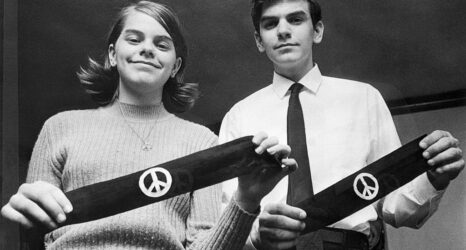Too often, pioneers like Barbara Cameron—a Hunkpapa Lakota, lesbian, Two-Spirit leader, AIDS activist and social organizer in San Francisco’s Native American community—are forgotten or written out of history.

Each March, we celebrate pioneering figures in women’s history. We rightly reflect on the accomplishments, insights, and leadership of women such as Harriet Tubman, Susan B. Anthony, Jane Addams and many more. These women changed the course of American history.
One such woman who helped change America, but who’s rarely remembered, is Barbara Cameron. Born on May 22, 1954, Cameron grew up on the Standing Rock Sioux Reservation. A Hunkpapa Lakota, Cameron packed a lot into her 47 years—a life of community organizing and activism on behalf of Two-Spirit people.
The term “Two-Spirit” is an umbrella term used to denote Native American people who embody both male and female spirits. Adopted by gay and lesbian Indians in 1990, Two-Spirit is an English translation of the Northern Algonquin word niiz manitoag. By adopting the term Two-Spirit, gay and lesbian leaders in Native American communities underscored their determination to make their fight against the twin prejudices of homophobia and racism visible to Native and non-Native Americans.
Barbara Cameron embraced this new term as a way to introduce Two-Spirit people to all Americans. But who was Barbara Cameron?
Cameron was a lesbian, an identity she described as “like a graceful but studied ballet.” She was raised by her grandparents and taught from an early age that she was “special.” Cameron certainly recalled feeling “different” as a child, which meant that the positive reinforcement that her grandparents provided was a welcome boost to her still developing sense of selfhood. Cameron’s self-confidence was also helped by the fact that she was a promising student.
“My grandparents always told me I could do anything I wanted or be anything I wanted,” Cameron later recalled. If her grandparents nurtured her, Cameron identified a role model in Beatrice Medicine, an anthropologist and Sihasapa and Minneconjou Lakota, whom Cameron strove to emulate.
Cameron left the reservation to pursue her educational dreams, first at the Institute of American Indian Arts in Santa Fe, New Mexico, and then at the San Francisco Art Institute. She arrived in San Francisco in 1973 and went on to have a successful career as an artist and photographer. But it was her work as a community organizer and activist that changed people’s lives.
In the 1970s, racism within San Francisco’s gay and lesbian community meant that LGBTQ Native Americans had few cultural outlets and limited social resources to call on. So, they created their own—and Cameron led these efforts.
In 1975 she co-founded Gay American Indians (GAI) with Randy Burns, a Northern Paiute. Together, Cameron and Burns became pioneers in San Francisco’s gay and lesbian Native American community. As a forerunner to contemporary organizations such as the Bay Area American Indian Two-Spirits (BAAITS), the GAI provided gay and lesbian Indians with a safe space to socialize, network, and to access information about support services.
In 1991, Cameron reflected on her personal journey and the changes she’d seen in San Francisco since the early 1970s. “In recent years,” Cameron observed, “two spirited people are becoming more visible in our communities.” By now a veteran of community organizing in San Francisco’s Two-Spirit community, Cameron saw this new term as a path to Native American empowerment.

The occasion for Cameron’s 1991 speech was the funeral of Phil Tingley. A gay Kiowa man, Tingley had moved to San Francisco from Oklahoma in 1971. A man of immense intelligence, compassion, and warmth, Tingley worked with Indigenous children and advocated for gay and lesbian Indians. These roles gave Tingley the opportunity to play an active role in building a sense of community for Two-Spirit people in the Bay Area. Tragically, AIDS took Tingley’s life too soon. It was now up to people like Cameron to continue his work.
Barbara Cameron had a capacious intellect and a keen understanding of American politics. Her personal papers, archived at the San Francisco Public Library, reveal the breadth of her intellect and the depth of her politic skills. These deeply personal writings reveal her passion to continually work for a more just society. In one unpublished essay, she writes “that my political activism is largely due to the fact that I am an Indian.” Growing up on the “rez,” witnessing the hypocrisy of organized Christianity, and learning about the United States government’s attempts to destroy Native communities inspired her political activism. Cameron distills all of this in her 1991 eulogy for Phil Tingley. It’s an incredible document: it’s a deeply personal testimony, poignant historical reflection, and a public celebration of Two-Spirit futures.
Cameron understood the importance of nurturing community among San Francisco’s gay and lesbian population. She also recognized that doing so meant confronting racism head-on. In fact, she never shied away from an opportunity to call out racism and homophobia in Native and non-Native communities. Her 1991 speech was no exception. “I’ve heard straight Indian people talk about homosexuality as a white man’s disease,” Cameron explained, “but it’s homophobia that is the white man’s disease.” Underscoring the historical significance of her message, Cameron insisted that “smallpox decimated many of our people and so has homophobia.”
With HIV/AIDS disproportionately impacted Native people in the early 1990s, and racism and homophobia still very much part of America’s political and cultural life in 1991, Cameron’s words underscored the fearlessness of her leadership.
But as a Two-Spirit pioneer, Cameron did more than confront prejudice; she inspired people. In that same speech, Cameron spoke about how “it’s important for us as Indian People as we reclaim and revitalize our languages and traditions to include the heritage and contributions of Indian lesbians and gay men.” She concluded with a profound yet succinct message that remains true today: “To know and understand that being lesbian or gay is an Indian tradition.”
Barbara Cameron dedicated her life to this message. In remembering the Phil Tingley’s legacy, she built on the knowledge he’d shared with her and which she in turn shared with her community. Importantly, Cameron wasn’t alone; there were other Two-Spirit pioneers in the 1990s. She shared the burden of leadership with people like Randy Burns, Clyde Hall, Stephen Barrios, Richard LaFortune, Janet Spotted Eagle, and many others who worked in San Francisco and in Two-Spirit communities across North America.
Cameron’s life ended suddenly in 2002, aged just 47. At her memorial service, Tom Ammiano, San Francisco Board of Supervisors president, remembered Cameron’s “fine qualities of heart and mind.” Cameron used these qualities to make life better for Two-Spirit people, to champion for the rights of those afflicted with AIDS, and to care for women impacted by violence.
Today, it’s worth reflecting on pioneering Two-Spirit leaders like Barbara Cameron. At an Elders panel organized to celebrate this year’s BAAITS powwow, the Southern Cheyenne Elder Marlin Fixico spoke movingly about how he is part of the “first generation of Two-Spirit Elders.” Of course, tribal communities across North America have long had specific traditions and titles to refer to people with fluid gender and sexual identities, but Fixico is right: He is part of the first generation of Elders to self-consciously nurture Two-Spirit identities and communities. It is a generation that builds on the life and legacy of Barbara Cameron.
Up next:





